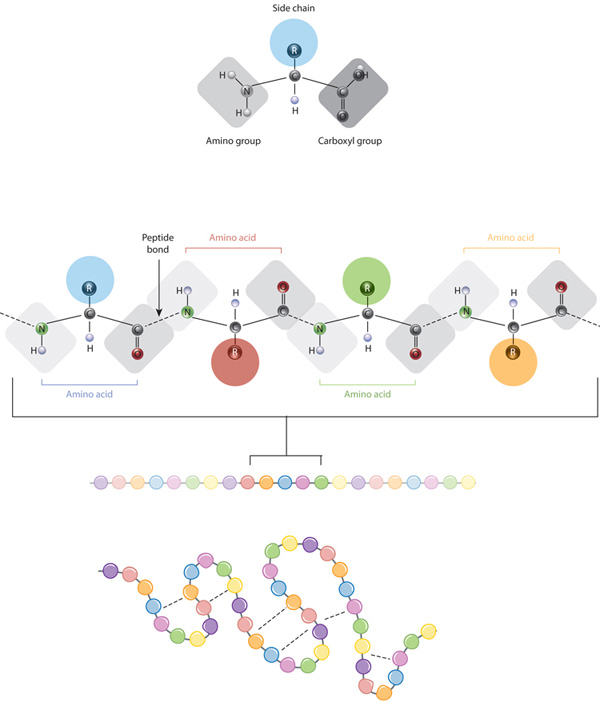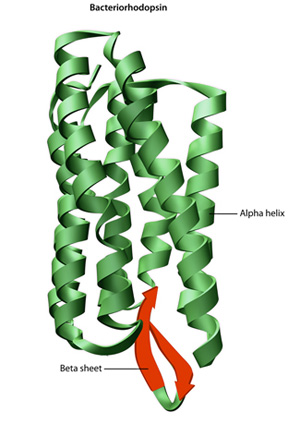What Is The Chemical Makeup Of Proteins
The edifice blocks of proteins are amino acids, which are small organic molecules that consist of an blastoff (cardinal) carbon atom linked to an amino group, a carboxyl grouping, a hydrogen atom, and a variable component called a side chain (see below). Within a poly peptide, multiple amino acids are linked together by peptide bonds, thereby forming a long chain. Peptide bonds are formed by a biochemical reaction that extracts a water molecule equally it joins the amino group of one amino acid to the carboxyl grouping of a neighboring amino acid. The linear sequence of amino acids within a poly peptide is considered the main construction of the protein.
Proteins are built from a set of only twenty amino acids, each of which has a unique side chain. The side chains of amino acids have different chemistries. The largest group of amino acids accept nonpolar side chains. Several other amino acids accept side chains with positive or negative charges, while others take polar merely uncharged side chains. The chemical science of amino acid side chains is disquisitional to protein structure because these side chains can bond with one another to agree a length of poly peptide in a sure shape or conformation. Charged amino acid side bondage tin form ionic bonds, and polar amino acids are capable of forming hydrogen bonds. Hydrophobic side chains collaborate with each other via weak van der Waals interactions. The vast majority of bonds formed past these side chains are noncovalent. In fact, cysteines are the only amino acids capable of forming covalent bonds, which they do with their item side chains. Because of side concatenation interactions, the sequence and location of amino acids in a detail protein guides where the bends and folds occur in that protein (Effigy one).

Effigy 1: The relationship between amino acid side chains and protein conformation
The defining characteristic of an amino acrid is its side chain (at top, blue circle; beneath, all colored circles). When connected together past a series of peptide bonds, amino acids form a polypeptide, some other word for protein. The polypeptide will then fold into a specific conformation depending on the interactions (dashed lines) between its amino acid side bondage.

Figure 2: The construction of the protein bacteriorhodopsin
Bacteriorhodopsin is a membrane protein in bacteria that acts as a proton pump. Its conformation is essential to its function. The overall structure of the protein includes both blastoff helices (greenish) and beta sheets (red).
The main construction of a poly peptide — its amino acid sequence — drives the folding and intramolecular bonding of the linear amino acid chain, which ultimately determines the protein'south unique three-dimensional shape. Hydrogen bonding between amino groups and carboxyl groups in neighboring regions of the protein chain sometimes causes certain patterns of folding to occur. Known every bit alpha helices and beta sheets, these stable folding patterns make up the secondary structure of a protein. Most proteins contain multiple helices and sheets, in add-on to other less common patterns (Figure ii). The ensemble of formations and folds in a single linear concatenation of amino acids — sometimes called a polypeptide — constitutes the tertiary structure of a protein. Finally, the quaternary structure of a poly peptide refers to those macromolecules with multiple polypeptide bondage or subunits.
The final shape adopted past a newly synthesized poly peptide is typically the most energetically favorable i. Every bit proteins fold, they exam a multifariousness of conformations before reaching their concluding form, which is unique and compact. Folded proteins are stabilized by thousands of noncovalent bonds between amino acids. In improver, chemic forces between a poly peptide and its immediate environment contribute to protein shape and stability. For example, the proteins that are dissolved in the jail cell cytoplasm have hydrophilic (h2o-loving) chemical groups on their surfaces, whereas their hydrophobic (h2o-averse) elements tend to be tucked inside. In contrast, the proteins that are inserted into the cell membranes display some hydrophobic chemical groups on their surface, specifically in those regions where the protein surface is exposed to membrane lipids. It is important to note, however, that fully folded proteins are not frozen into shape. Rather, the atoms inside these proteins remain capable of making pocket-size movements.
Even though proteins are considered macromolecules, they are as well modest to visualize, fifty-fifty with a microscope. So, scientists must use indirect methods to figure out what they look similar and how they are folded. The most common method used to study protein structures is 10-ray crystallography. With this method, solid crystals of purified protein are placed in an X-ray beam, and the pattern of deflected X rays is used to predict the positions of the thousands of atoms within the protein crystal.
What Is The Chemical Makeup Of Proteins,
Source: https://www.nature.com/scitable/topicpage/protein-structure-14122136/
Posted by: crowesuccionoth.blogspot.com



0 Response to "What Is The Chemical Makeup Of Proteins"
Post a Comment